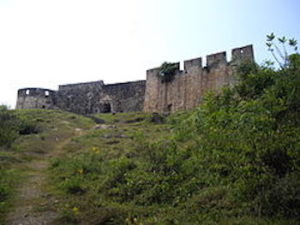
Fort Amsterdam
*Fort Amsterdam is remembered on this date in 1631. The British and Dutch used this Fort to facilitate Black African slave labor in the Middle Passage.
The English built it between 1638 and 1645 as Fort Cormantin and captured it by the Dutch West India Company in 1665 in retaliation for the English's capture of several Dutch forts in 1664. Subsequently, it was part of the Dutch Gold Coast until the Fort was traded to the British in 1868. The Fort is located northeast of Cape Coast in Kormantin, Central Region, Ghana.
Fort Amsterdam had a rectangular outline with two square and two round bastions at the corners. Curtain walls linked them, and there was a central courtyard. Arranged around it were a one-storied building on the west, a two-storied building along the north, and a line of two or three-storied buildings on the south. The curtain and bastion on the north were solid, while the others were constructed with earth filling between two walls of stone laid in mortar. The result was cracks and disintegration when it was left unoccupied.
The stronghold on the southeast, which was designed to be hollow, had grated ventilation in the roof and was, in addition, used as a slave prison. Built with African stone masonry and carpenters, it is believed to have been the first of its kind on the Gold Coast. Slaves taken from this Fort were said to have been named "Coromantese.” From 1705 to 1716, trade figures at the Fort were given as 481 marks of gold and 149 slaves.
There were also complaints of little trade at other times. Due to wars, it was said that the local chief had leased the site to the British, rather than the Dutch. The Dutch had no jurisdiction there, and the Cormantin people blocked their trade routes whenever it suited them until the former had paid vast sums of money. The estimated business era was Britain from 1631 to 1665 and the Netherlands from 1665 to 1868.